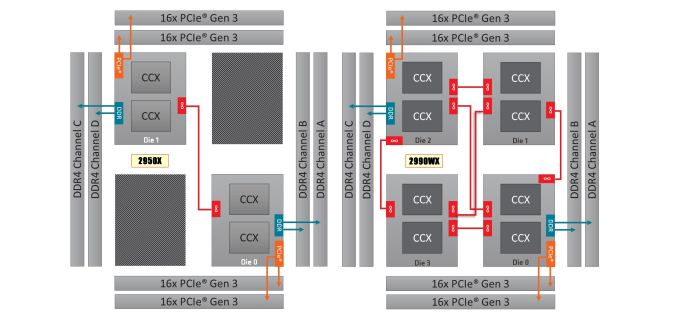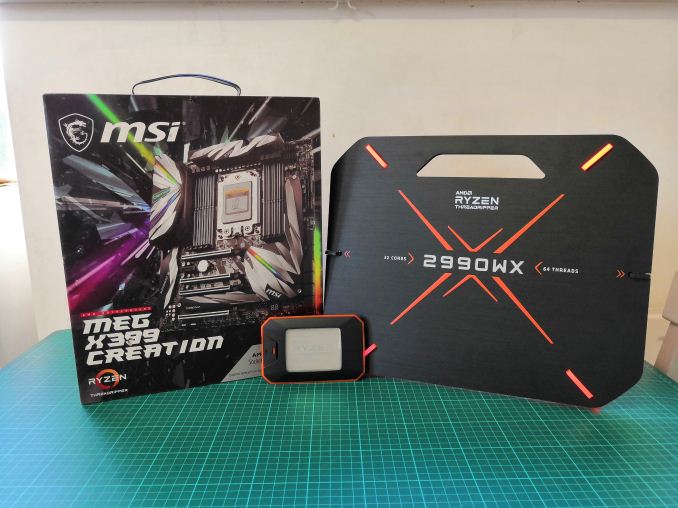The AMD Threadripper 2990WX 32-Core and 2950X 16-Core Review
by Dr. Ian Cutress on August 13, 2018 9:00 AM ESTConclusions: Not All Cores Are Made Equal
Designing a processor is often a finely tuned craft. To get performance, the architect needs to balance compute with throughput and at all times have sufficient data in place to feed the beast. If the beast is left idle, it sits there and consumes power, while not doing any work. Getting the right combination of resources is a complex task, and the reason why top CPU companies hire thousands of engineers to get it to work right. As long as the top of the design is in place, the rest should follow.
Sometimes, more esoteric products fall out of the stack. The new generation of AMD Ryzen Threadripper processors are just that – a little esoteric. The direct replacements for the previous generation units, replacing like for like but with better latency and more frequency, are a known component at this point and we get the expected uplift. It is just this extra enabled silicon in the 2990WX, without direct access to memory, is throwing a spanner in the works.
2950X (left) and 2990WX (right)
When some cores are directly connected to memory, such as the 2950X, all of the cores are considered equal enough that distributing a workload is a fairly easy task. With the new processors, we have the situation on the right, where only some cores are directly attached to memory, and others are not. In order to go from one of these cores to main memory, it requires an extra hop, which adds latency. When all the cores are requesting access, this causes congestion.
In order to take the full advantage of this setup, the workload has to be memory light. In workloads such as particle movement, ray-tracing, scene rendering, and decompression, having all 32-cores shine a light means that we set new records in these benchmarks.
In true Janus style, for other workloads that are historically scale with cores, such as physics, transcoding, and compression, the bi-modal core caused significant performance regression. Ultimately, there seems to be almost no middle ground here – either the workload scales well, or it sits towards the back of our high-end testing pack.
Part of the problem relates to how power is distributed with these big core designs. As shown on page four, the more chiplets that are in play, or the bigger the mesh, the more power gets diverted from the cores to the internal networking, such as the uncore or Infinity Fabric. Comparing the one IF link in the 2950X to the six links in 2990WX, we saw the IF consuming 60-73% of the chip power total at small workloads, and 25-40% at high levels.
In essence, at full load, a chip like the 2990WX is only using 60% of its power budget for CPU frequency. In our EPYC 7601, because of the additional memory links, the cores were only consuming 50% of the power budget at load. Rest assured, once AMD and Intel have finished fighting over cores, the next target on their list will be this interconnect.
But the knock on effect of not using all the power for the cores, as well as having a bi-modal operation of cores, is that some workloads will not scale: or in some cases regress.
The Big Cheese: AMD’s 32-Core Behemoth
There is no doubting that when the AMD Ryzen Threadripper 2990WX gets a change to work its legs, it will do so with gusto. We were able to overclock the system to 4.0 GHz on all cores by simply changing the BIOS settings, although AMD also supports features like Precision Boost Overdrive in Windows to get more out of the chip. That being said, the power consumption when using half of the cores at 4.0 GHz pushes up to 260W, leaving a full loaded CPU nudging 450-500W and spiking at over 600W. Users will need to make sure that their motherboard and power supply are up to the task.
This is the point where I mention if we would recommend AMD’s new launches. The 2950X slots right in to where the 1950X used to be, and at a lower price point, and we are very comfortable with that. However the 2950X already sits as a niche proposition for high performance – the 2990WX takes that ball and runs with it, making it a niche of a niche. To be honest, it doesn’t offer enough cases where performance excels as one would expect – it makes perfect sense for a narrow set of workloads where it toasts the competition. It even outperforms almost all the other processors in our compile test. However there is one processor that did beat it: the 2950X.
For most users, the 2950X is enough. For the select few, the 2990WX will be out of this world.












171 Comments
View All Comments
eva02langley - Tuesday, August 14, 2018 - link
You don't get it, it is a proof of concept and a disruptive tactic to get notice for people to consider AMD in the future... and it works perfectly.KAlmquist - Thursday, August 16, 2018 - link
That's what I meant by “bragging rights.”eva02langley - Thursday, August 16, 2018 - link
You are missing the business standpoint, the stakeholders and the proof of concept.Nvidia is surfing on AI, however the only thing they did so far is selling GPU during a mining craze, however people drink their coolaid and the investors are all over them. The hangover is going to be hard.
Lolimaster - Monday, August 13, 2018 - link
If you're a content creator the Threaripper 2950X is you bitch, period.MrSpadge - Tuesday, August 14, 2018 - link
Ian, does the power consumption of uncore (IF + memory controller) scale with IF + memory controller frequency? I would expect so. And if not: maybe AMD is missing on huge possible power savings at lower frequencies. Not sure if overall efficiency could benefit from that, though, as performance and power would simulataneously regress.dynamis31 - Tuesday, August 14, 2018 - link
It's not all silicon !Windows OS and applications running on that OS may also be software optimised for more 2990WX workloads as you can see below :
https://www.phoronix.com/forums/forum/phoronix/lat...
dmayo - Tuesday, August 14, 2018 - link
Meanwhile, in Linux 2990WX destroyed competition.https://www.phoronix.com/scan.php?page=article&...
https://www.phoronix.com/scan.php?page=article&...
eva02langley - Tuesday, August 14, 2018 - link
I am beginning to ask myself if this is related to Windows. Or maybe the bench suites reliability toward such a unique product.But yeah, these results are insane.
MrSpadge - Tuesday, August 14, 2018 - link
Crazy results, indeed. And quite believable, considering how well the 16 core TR fares in comparison in many windows benches. I suspect the scheduler is not yet tuned for the new architecture with 2 different NUMA levels.And for at least parts of the benchmarks I suspect something a lot less technical is happening: Phoronix can only bench cross-platform software for this comparison. However, hardly any Windows programmer is regularly building Linux versions. That leaves just another option: Linux programs which also got a Windows build. And considering how downright hostile Linux fans can be towards Windows and anything Microsoft-related, I wouldn't be surprised if the tuning going into these compilations was far from ideal. Some of these guys really enjoy shouting out loud that they don't have access to any Windows machine to test their build (which they only did to stop the requests flooding their inbox) and to shove down their users throat that Windows is a second class citizen in their world. This point is reinforced by the wierd names of many of the benchmarks - except 7-zip, is anyone using those programs?
GreenReaper - Wednesday, August 15, 2018 - link
Most aren't dedicated benchmarks, they're useful programs being run as such:* x264 powers most CPU-based H.264/AVC video encoding. Steam uses it, for example.
* GraphicsMagick is a fork of ImageMagick, one of which is used in a large number of websites (probably including this one) for processing images.
* FFmpeg is for audio and video processing.
* Blender is a popular open-source rendering tool.
* Minion is for constraint-solving (e.g. the four-colour map problem).
Many aren't the kind of things you'd run on a regular desktop - but a workstation, sure. They are CPU-intensive parallel tasks which scale - or you hope will scale - with threads.